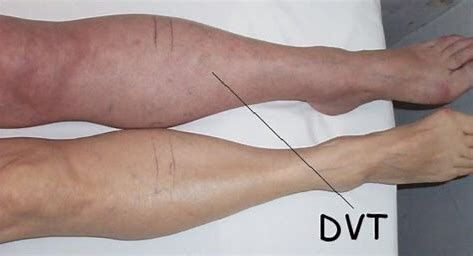Deep Vein Thrombosis (DVT)
What is Deep Vein Thrombosis?

Deep vein thrombosis (DVT) occurs when a blood clot forms in the deep venous system, usually in the legs. The clot blocks blood flow resulting in leg discomfort that can become increasingly uncomfortable and cause harm. Small clots may form, and produce no symptoms at all, but still pose a medical threat. Therefore prompt attention is necessary as serious complications can occur, such as a clot fragment that breaks loose, travels toward the torso, and becomes lodged in the lungs as a pulmonary embolism (PE). PEs put extreme strain on the heart and lungs and can close off critical circulatory and vascular pathways.
The signs and symptoms of DVT are similar to those of venous reflux in the superficial venous system. If you suspect that you may have either condition, a consultation with our venous experts and ultrasound exam can determine the location of clotting and or reflux in your system.
Signs That People With DVT Often Experience
- Leg pain, especially when standing, climbing stairs or walking
- Leg swelling in the affected area
- Skin that is warm to the touch
- Leg fatigue
- Skin discoloration
- Swollen, bulging veins on the legs (varicose veins)
Common Risk Factors For DVT
- Age
- Surgery
- Trauma
- Obesity
- Pregnancy
- Family history / genetics
- Prolonged immobility (resting or sitting for long period of time)
- Oral contraceptives
- Smoking
- Cancer
It is true that prolonged sitting such as a transcontinental flight or a long road trip increases DVT risk, so it is important to take walking breaks or perform calf raises in your seat when traveling long distances.
DVT that goes untreated can also lead to the development of post-thrombotic syndrome or post-phlebitic syndrome. This is a debilitating condition that causes vein bulging, leg swelling, pain, a bursting sensation when walking, skin discoloration or open leg sores. Clot growth and expansion within the vessels damages the vein walls and valves, which allows blood to leak in the wrong direction towards the foot. This also happens with venous reflux in the superficial venous system. As the pressure builds in the area, it leads to significant leg discomfort and unsightly appearance. The use of medical-grade compression support stockings brings significant relief and support during the proper course of therapy.
A simple, non-invasive ultrasound exam can determine the presence of DVT within your deep venous system. If the exam indicates that you have a DVT, our board-certified vascular surgeons will take the proper measures to provide the necessary care.
DVT Treatment
DVT treatments range from conservative therapies that prevent and manage clotting symptoms to clot removal for improved blood flow and alleviation of pain.
Anticoagulation (Blood Thinners)
Anticoagulation is the method most commonly used to treat DVT, which requires blood thinning medications to prevent the body from forming new clot. Through this process, the body’s enzymes work toward dissolving the clot and reduces the ability of blood to coagulate and clot . Blood thinning treatment previously required hospitalization, injections and/or a series of blood tests. Advancements in blood thinners has now made outpatient treatment a safe and effective solution for treating DVT.
Thrombectomy (Clot Removal)
Clot removal is a treatment option that uses a medical device to remove blood clots. This may be necessary for individuals with acute DVT (clot in its early stages), to prevent further disruption to the venous anatomy and system, particularly in individuals with severe clotting issues. It is accompanied by anticoagulation with blood thinners.
Filters
Intravenous filters may be used in individuals when anticoagulants cannot be used or do not work sufficiently to address their disease state. During this procedure, vascular experts place a specialized, highly durable surgical filter inside the vein to capture and trap embolus (a clot that is moving through the vein) before it reaches the lungs.
Thermal therapy is not an indication for use in patients with DVT. Blood flow in the deep venous system cannot be shut down or redirected into healthier veins as with veins in the superficial venous system. Other therapies like anticoagulation can bring relief from painful signs and symptoms and improve leg health.
Your physician will recommend the best treatment options for you based on the extent of your condition, your ultrasound exam, and other risk factors and presentations.
Getting Started
Contact us to learn more and whether you are at risk for DVT and or post-thrombotic syndrome. We offer screenings and same-day ultrasound appointments, upon availability.
References:
- Antithrombotic therapy for venous thromboembolism disease: Antithrombotic Therapy and Prevention of Thrombosis, 9th ed: American College of Chest Physicians Evidence-based Clinical Practice Guidelines. Kearon C, et al. Chest. 2014 Feb;141(2 Suppl):e419S-94S
- The post-thrombotic syndrome and compression therapy. Van der Velden S, Neumann H. Phlebology. 2014 May 19;29(1 suppl):83-89
